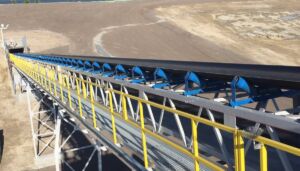Conveyor systems are necessary in many industries, helping to move materials from one point to another efficiently. A crucial component of these systems is the Industrial conveyor idler, a seemingly simple but vital part that ensures smooth and efficient operation. In this article, we’ll discuss the various types of conveyor idlers, their role in material handling, and the importance of ensuring proper maintenance.
What are Conveyor Idlers?
Heavy-duty conveyor idlers are sets of rollers that support the conveyor belt along its path. They come in various categories, each designed for specific functions and applications:
- Carrying idlers: These idlers support the weight of the loaded belt on the carrying side of the conveyor. For troughed belts they’re arranged in sets of three to form a trough shape, increasing the belt’s carrying capacity.
- Return idlers: Located on the return side of the conveyor, these idlers support the unloaded belt, ensuring proper alignment and tracking.
- Impact idlers: Designed to absorb the shock of heavy loads, impact idlers protect the belt from damage during loading, particularly in industries like mining and construction.
- Training idlers: These heavy-duty conveyor idlers guide the belt and prevent misalignment, ensuring smooth operation and preventing belt wanter.
What is the Purpose of a Conveyor Idler?
Conveyor idlers play a critical role in the efficiency and longevity of a conveyor system. They reduce friction between the belt and the conveyor structure, minimizing wear and tear on the belt. By supporting the belt and its load, idlers ensure efficient material transport and prevent sagging or misalignment. Properly functioning idlers contribute to a safer working environment by preventing belt slippage and material spills.
The Consequences of Conveyor Idler Misalignment
Misalignment of conveyor idlers can lead to a host of problems, including increased belt wear, material spillage, and energy loss. Misalignment can occur in three ways:
- Vertical Misalignment: One side of the idler set is higher than the other, causing the belt to shift sideways.
- Lateral Misalignment: The idler’s center is not aligned with the belt’s center, leading to uneven belt height and edge wear.
- Angular Misalignment: The idler axis is not perpendicular to the belt’s direction, resulting in slippage and increased friction.
Misalignment can be caused by structural impacts, improper maintenance, or excessive carryback.
Choosing the Right Conveyor Idlers
Selecting the appropriate conveyor idlers is necessary for maintaining optimal performance. Factors to consider include:
- Material Handling Needs: The type, weight, and volume of materials being transported.
- Conveyor System Design: Whether the conveyor is horizontal, inclined, or a combination of both.
- Construction and Durability: The materials used for the idlers, such as steel, plastic, or rubber, and their suitability for the operating environment.
- Environmental Conditions: Temperature, moisture, dust, and debris can all affect idler performance.
Furthermore, conveyor idlers must adhere to Conveyor Equipment Manufacturer’s Association (CEMA) Standards.
At Luff Industries, we offer a variety of CEMA-standard conveyor belt idlers, including:
- Equal Roll Steel
- Equal Roll Impact
- Steel Return Roll
- Rubber Disc Return
- Flat Carrying
- Flat Impact
- Rough Training
- Steel Return Training
- Disc Return Training
- Unequal Roll Steel
- Unequal Roll Impact
- Offset Centre Roll Steel
- Steel V-Return
- Disc V-Return
- High-Speed Spreader
Our high-quality idlers can stand up to harsh working conditions are manufactured with:
- High-strength and impact-resistant polymer endcaps
- Sealed bearings that protect against dust and moisture contamination
- Corrosion-resistant designs
- Endcaps that eliminate sharp edges and prevent belt tears
- Additional protective components include Safety Anti-Lock Shield and High Moisture Seal
Luff Industries: Your Leader in CEMA-Compliant Idlers
Industrial conveyor idlers are essential components of any conveyor system, ensuring efficient material transport and preventing damage to the belt. Proper selection, installation, and maintenance of idlers are crucial for optimal performance and longevity of the system. By understanding the different types of idlers, their functions, and the importance of proper alignment, you can make informed decisions to maximize the efficiency and lifespan of your conveyor system.
To learn more about our offerings and finding the right idler for your conveyor system, contact us today.




